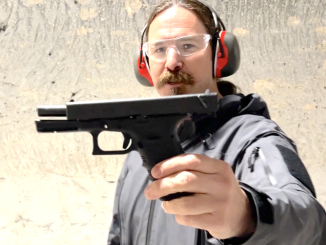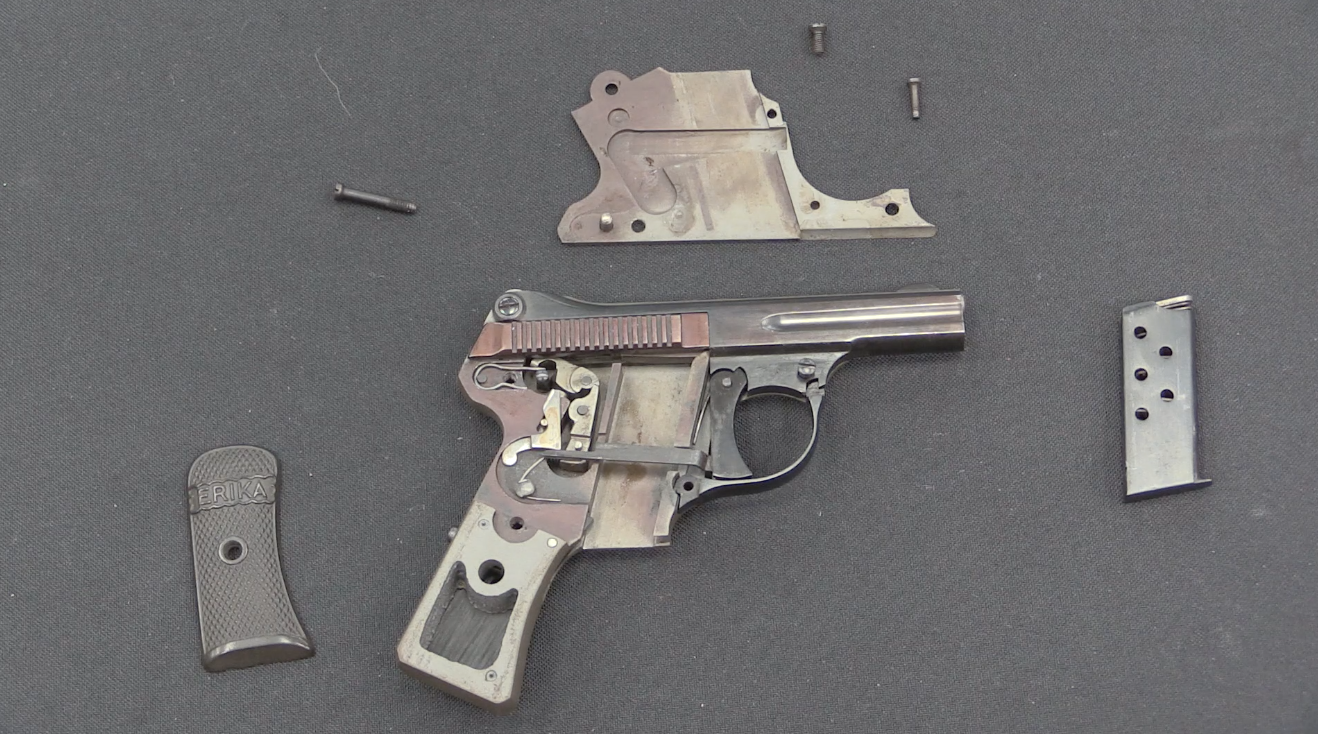This is quite the eye-catching pair of revolvers…
The Model 1870 Gasser was a behemoth of a pistol designed by Leopold Gasser for the Austro-Hungarian cavalry – it was built around the 11x36mm cartridge used in their Werndl cavalry carbines. This cartridge was a middle ground between rifle and pistol; light enough to not produce punishing recoil when fired from a short and light carbine, but fairly huge for a revolver. But it was not in the hands of those cavalry troops that these guns gained their notoriety.
Instead it was during the reign of King Nicholas of Montenegro from 1910 to 1918 that they saw their prominence appear. Nicolas decreed that all his male subjects must own a Gasser-pattern revolver under penalty of law. This was ostensively a move to make the tiny Montenegrin kingdom less vulnerable to conquest by any one of its larger neighbors, but allegedly may have also had something to do with the King owning stock in the Gasser firm.
At any rate, the law called for Gasser-*pattern* guns (not necessarily the real thing), and so a substantial demand flourished for Spanish and Belgian guns of that basic design. They were made in a huge variety of flavors; solid frame and hinged, long barrels and short, and many different specific cartridges, finishes, and levels of embellishment. With every man required to own one, the revolver naturally became a status symbol, with the more well-off showing their wealth through a highly decorated sidearm.
Whether you appreciate the style of these two or not, they certainly catch the eye!




This is gaudy – show of poor taste of owner and probably merely enforcement of his social status. But even with that ‘sticker’ it is good to see.
I found this styling inconsistent – grip heavily decorated but rest without any decoration.
BTW. How they defined Gasser-*pattern* guns or how they decided this gun is and this is not?
I suspect that while Gasser may have been an Austrian company, the grip was likely added by a local gunsmith/artist after purchase.
Austrian artistic conventions and styles would have been quite different from southern Balkan styles, which were heavily influenced by the Ottoman Empire of which they were part.
Most of them never left the holster, so that adornment would make sense for someone who wanted to show status.
I am in line with MG’s explanation. It was the known pattern of the time and all involved in the trade were tuned into it. The Turkish influence is definitely there.
More like Byzantine influence, there are such decoration types as early as 11-12th century on Balkans.
Grips were decorated due the way those were carried, tucked in the belt with a traditional dress.
It’s ugly, looks like a child’s arts and crafts project, but I know I wouldn’t be laughing at the stocks while starring at the business end of the muzzle of this pistol. Interesting historical piece.
“cartridge was a middle ground between rifle and pistol; light enough to not produce punishing recoil when fired from a short and light carbine, but fairly huge for a revolver”
Here: http://www.municion.org/Montenegrin/Montenegrin.htm
you can see .45 Colt and Montenegrin cartridge on one photo for size comparison
That is a mother of cartridge… I did not know it was that big. I expect Bojan to show up and tell us more.
It was a handy cartridge, but it was gradually downloaded in Austrian service, from initial 2.3g of black powder in M.1870 loading to something like 1.8g in M.1889 loading. Reason – revolvers were getting worn out rapidly. Cylinder gap was big issue and would become untolerably large after ~500-600 rounds of full power ammo. It fired 20g (312 grains) soft lead bullet.
Neither of those was identical to carbine load, as it used 3.2-3.4g of black powder. Revolver cartridges had 3-4mm thick cardboard or felt spacer inside, carbine did not.
Ammo was however identical to a rare Fruwirth gendarme carbine, that was also used by Montenegro…
Cartridges my friend opened and measured charge varied from 1.6g to 2.7g of black powder, depending on manufacture, hottest loaded ones were Montenegrin and Austrian. Belgian made ammo loads were 1.6-2.1g.
Some corrections were in order however:
– Nikola was not stockholder in a company, but Montenegrin state acquired revolvers from Gasser @ 15 A-H gulden and sold them for 18, making 3 gulden in profit. To compare, sheep cost about 4-8 gulden, cow about 10-15.
– such silver (also pearl and ivory) grips were officially forbidden if you only had one gun. Solution – people would buy multiple guns and keep one plain.
– It was not Gasser type, it was explicitly stated “Guns made by Gasser Factory”. Belgian copies were explicitly forbidden actually, officially due the low quality of copies, practically due the state not getting their 3 gulden.
– Only model formally allowed was 1870/74 open frame with 9″ barrel (230mm). In early 1890s it was allowed (and was available for sale) to officially get breakdown and closed frame model with 5″ barrel. Those were sometimes called officer’s or artillery, but only requirement to get one was to already own 1870/74 model.
– NI under crown mark was often faked, to make guns appear as they have passed Montenegrin inspection.
– Nikola/Nicolas ruled for 58 years actually, 1860-1918… For the Balkans, that was quite something. https://en.wikipedia.org/wiki/Nikola_I_Petrovi%C4%87-Njego%C5%A1
– Ian missed safety mechanism on the right side, which held it very securely on half cock, making them quite safe to carry with all chambers loaded, and could be fired DA from half-cock (as evidenced in video).
– Montenegrins won Battle of Mojkovac due the massive use of revolvers even if horribly outnumbered (30000 vs 6500), in desperate close combat in trenches and forest surrounding small town of Mojkovac. https://en.wikipedia.org/wiki/Battle_of_Mojkovac
-Austro-Hungarians did not surplus their, they were most common sidearms in A-H army when a war started… They refurbished some during the war, shortening barrels to ~5″.
-There was abortative attempt to manufacture those in Montenegro, less then 10 were made and two are known to survive – one in museum in Russia, other was sold about year ago at RIA…
I fired those (9″ 1870/74 and 5″ 1877 breakdown models, both original Austrian manufacture), with original 1905 Montenegro made ammo with 2.3g powder load, it was impressive to say at least… Velocity measured was ~250m/s for 9″ and ~210m/s for 5″ barrel.
Cases can be made from 7.62x54R, 45-70, 8x50R and 8x56R Mannlicher. Bullets are usually .445, but this can vary, sometimes up the .455-.456 and down .435-.437. I would not load more than 24-30 grains of powder, preferably as low as 20 grains for Belgian and Spanish copies.
Out of the 9″ barrel at 820 F/S, the 312-grain bullet was generating about 465 FPE, equivalent to the .45 (Long) Colt from the 7.5″ “cavalry” barreled Peacemaker or a modern day “mid-level” .357 Magnum load. Out of the shorter barrel, it was moving at about 690 F/S for 320 FPE, or about the energy of a modern .45 ACP or 9 x 19mm.
This would make either one a pretty emphatic handgun for its day. Although I would expect all the fancywork on the butts of these two to draw blood due to recoil. Wearing gloves would be highly advisable.
In fact, I’m guessing that these grips were intended strictly for “show”, and that in actual use they would have had these geegaws removed and the standard smooth or checkered wooden grips put back on.
cheers
eon
That is quite an account Bojan!
Just wondering – how they distinguished between shots with different loadings (for pistols and carbines)? Thanks.
Recoil is surprisingly light, due the gun having about 1.8kg loaded… It jumps a bit (quite a bit), but it can be more acurately described as a “push” rather then a “kick”. So, I doubt those grips would really hurt you…
Denny, IDL, other than a packaging there is no real external distinction between M.1867 carbine and M.1870 revolver loading other than packaging they came in. Majority of carbine ammo had paper patched bullets, but not all. Internally, carbine did not have a cardboard/felt spacer. M.1882 (not 1889) loading had shorter case, 29mm in length. It did not have cardboard/felt spacer inside.
http://www.municion.org/Montenegrin/11_2x30RGasser.htm
Belgian ammo often had 32-33mm long cases, if loaded to original load (rare) they lacked spacer, but if downloaded they had them.
To add, Nikola had fantastic collection of weapons, including 12″ barreled Colt SAA, S&W Russians, matching Luger 1902 pistol and carbine (personal gift from Georg Luger who worked as sales representative for DWM selling Maxim guns to Montenegro), Lancaster howdah pistol, and much more. A lot of those were looted in WW1 by Austrians and WW2 by Germans and Italians, some of it surfaced, some was lost forever….
Just a note: “GUSS STAHL” is a type of steel, as you said. Precisely – casted one – which is quite visible at closer look.
The rarely seen “carbine-caliber pistol”. I wonder if these were generally carried in saddle holsters?
Maybe. This is the closest thing to a Colt Single Action Army in Europe. Huge bore single action revolver with hinged ejector door… And getting bashed with such a gun would hurt a lot!
Double action and could be safely carried with all chambers loaded unlike SAA.
“Peacemaker of Balkans” would be appropriate nickname.
Oops. Sorry about that. In any case, you do not want to be on the receiving end of whatever is loaded in a Gasser revolver.
If I was to compare with engines, I’d call it large bore, low revs and huge torque.
“If I was to compare with engines, I’d call it large bore, low revs and huge torque.”
I see some similarity between BLACKPOWDER-NITROPOWDER and STEAM(PISTON)ENGINE-INTERNAL-COMBUSTION-ENGINE. There are similar in general idea (piston moving inside cylinder) but differs in real world: steam locomotive have, most commonly, 2 cylinders when diesel locomotive often have 12 cylinder, although of smaller sizer, steam engine can be directly linked to axle, when diesel need gearbox, etc.
“This is the closest thing to a Colt Single Action Army in Europe”
Webley No.5 revolver is closer match:
http://www.historicalfirearms.info/post/81121711323/webley-no5-army-express-webley-produced-their
it is DA unlike Colt Single Action, but it can fire (not only) American ·45 U.S. Cavalry cartridges.
AH used both saddle and belt holsters.
In Montenegro, they were usually carried “pirate style” tucked into belt. In ww1 people used this way, and also wide variety of holsters, mostly cross-draw.
Please i live in beirut lebanon how can i attach a photo here for my gasser montinegrin so that u can evaluate my gun i am not a gun collector